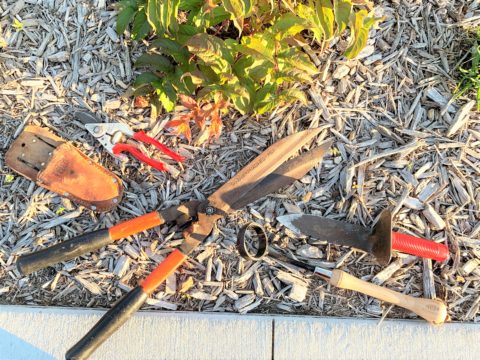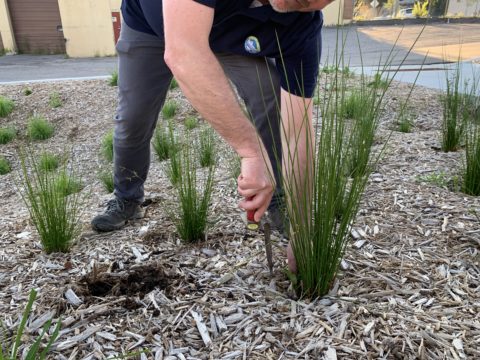Do you have a rain garden? Capitol Region Watershed District (CRWD) provides support for Clean Water Project Grantees by conducting follow-up site visits to offer suggestions and guidance, and by hosting workshops like the recent Rain Garden Maintenance Workshop. Check the Gardening Guide PDF to help you maintain the beauty, health and performance of your rain garden. With proper care, your garden will continue to help keep our lakes and the Mississippi River clean by capturing runoff and removing pollution.
 General Gardening Tips
General Gardening Tips
Andrew Novak, former CRWD Urban BMP Specialist and resident gardening expert, recommends the following tools for garden maintenance: hand pruners, a square blade shovel, a circle hoe, and serrated garden digger.
Remove weeds while they’re young and small. Especially tree seedlings! Trees quickly put out large root systems that are difficult of remove once established. Pull out weeds by the roots, getting as much of the root system as you can to prevent the weeds from returning. Need help spotting a weed? Look it up online at the University of MN Extension – Diagnose a problem. Your garden planting plan is also a great way to identify weeds or plants that don’t belong. Not on your plan? Pull it!
Homeowners often ask about what plants are okay for their gardens. You don’t have to stick to your original planting plan. Add to or adapt your rain garden as needed. Try different ideas and experiment to suit your preferences. Blue-thumb.org has a great plant finder with information on dozens of rain garden plants. Look for local businesses that carry native plants and seeds.
 CRWD recommended native perennials for rain gardens include cardinal flowers, sensitive ferns, pink turtlehead, prairie blazing star, little bluestem, swamp milkweed, blue flag iris, dwarf bush honeysuckle, butterfly weed, fox sedge, purple dome aster and switchgrass.
CRWD recommended native perennials for rain gardens include cardinal flowers, sensitive ferns, pink turtlehead, prairie blazing star, little bluestem, swamp milkweed, blue flag iris, dwarf bush honeysuckle, butterfly weed, fox sedge, purple dome aster and switchgrass.
Seasonal Rain Garden Maintenance
FALL
• Remove or replace plants, especially poor-performing ones.
• Fall is a great time to find bargain nursery plants. Added bonus – you won’t have to keep watering them all summer like you would with spring plantings.
• Clean up leaves from the garden or inlet. Mulch with leaves and grass clippings.
• If desired, leave native plants for winter as food and cover for wildlife. Pollinators will use native plant stalks as nests. Stalks can also add beauty and visual interest to the winter landscape.
• Prune shrubs and plant stalks when dormant after first frost.
WINTER
• Replace mulch in early winter (before snow cover) where needed
• Remove trash and debris from the garden
• Avoid snow piles or chemicals (i.e. salt) on the garden when possible. Large snow piles add to soil compaction and can delay spring thaw. However, sometimes they are unavoidable.
SPRING
• Remove garden “duff” of winter. Clean up the garden by removing unattractive dead plants, seeds, stalks and any decaying material.
• Thin or prune over-crowded or overgrown plants.
• Spring is the ideal time to divide and transplant most plants.
• Add, move or divide plants if crowded or to cover bare areas.
• Get the weeds while they’re young and small! Weed mid-to-late May (before Memorial Day, or when dandelions first turn yellow).
• Clear inlets or pipes of any obstructing materials. Sand and dirt from the street should go in the trash.
SUMMER
• Prune/cut back decaying, unattractive or taller plants.
• Remove warm-season weeds by the 4th of July and late-summer weeds by mid-August.
Results
Since the CRWD Clean Water Project Grant Program began in 2003 there have been over 350 projects completed across the District. All the projects add up to improve water quality! Annually, these projects remove 24 lbs. of phosphorus (that’s the equivalent of 12,070 lbs. of algae) and 7,635 lbs. of sediment a year. And they clean 9 million gallons (13.5 Olympic-sized pools) of water. Thank you to all the stewardship grantees for protecting our lakes and the river!
Curious about what else you can do to protect our lakes and the river?
– Become a Minnesota Water Steward. CRWD, in partnership with the Freshwater Society, offers a Minnesota Water Steward certification for District residents who are committed to keeping lakes and rivers clean. Minnesota Water Stewards are trained to help other community members prevent pollution and advocate for clean water in their communities. Visit minnesotawaterstewards.org to learn more.
– Sign up to adopt a storm drain near your home! If it’s in the street, it ends up in our lakes and the Mississippi River. Help us keep leaves, grass, salt, trash and dirt out of the stormwater system by adopting a drain in your neighborhood. Visit adopt-a-drain.org to learn more and sign up.
– Join the CRWD Citizen Advisory Committee. CRWD’s Community Advisory Committee (CAC) assists the Board of Managers with organizational development, planning processes and program implementation. The CAC strengthens the connections between CRWD and District residents. Meetings are on the second Wednesday of the month from 7 – 9 pm and are open to the public.
